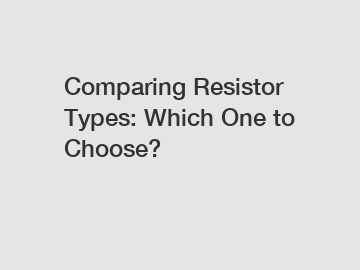Comparing Resistor Types: Which One to Choose?
When it comes to choosing the right resistor for your electronic project, there are many factors to consider. From the type of resistor to the material it is made of, each component plays a crucial role in determining the performance and reliability of your circuit. In this blog post, we will compare different types of resistors and help you decide which one is best suited for your needs.
The most common type of resistor is the carbon film resistor. These resistors are made from a ceramic rod coated with a thin film of carbon. They are inexpensive, easy to manufacture, and have a high degree of accuracy. However, carbon film resistors are not very stable at high temperatures and can drift over time.
Another popular type of resistor is the metal film resistor. These resistors are made by depositing a thin film of metal (usually nickel-chromium) onto a ceramic rod. Metal film resistors are more stable than carbon film resistors and have a lower temperature coefficient. They are also more precise and have a higher power rating. However, metal film resistors are more expensive than carbon film resistors.

For applications that require very precise resistance values, precision resistors are the best choice. These resistors have a tight tolerance (typically 1% or 0.1%) and are highly stable over time and temperature. Precision resistors are often used in instrumentation and measurement equipment where accuracy is critical.
If you need a resistor that can handle high power levels, wire wound resistors are a good option. These resistors are made by winding a wire (usually made of an alloy like nichrome) around a ceramic or fiberglass core. Wire wound resistors have a high power rating and are highly stable over a wide temperature range. However, they are bulky and more expensive than other types of resistors.
If space is a concern, surface mount resistors may be the best choice for your project. These resistors are much smaller than traditional through-hole resistors and are designed to be mounted directly onto the surface of a printed circuit board. Surface mount resistors are available in a variety of sizes and power ratings, making them ideal for compact electronic devices.
When selecting a resistor, it is also important to consider the material it is made of. While carbon film and metal film resistors are the most common, there are other materials available, such as thick film, thin film, and fusible resistors. Each material has its own strengths and weaknesses, so be sure to choose the one that best fits your specific application.
In conclusion, when choosing a resistor for your electronic project, it is important to consider factors such as accuracy, stability, power rating, and size. By understanding the different types of resistors available and their respective characteristics, you can make an informed decision about which one is best suited for your needs. Whether you need a high-precision resistor for a measurement application or a high-power resistor for an amplifier, there is a type of resistor that is perfect for your project.
If you want to learn more, please visit our website film type resistor, Xieyuan Electronic, how many types of resistor.



